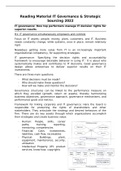Reading Material IT Governance & Strategic
Sourcing 2022
IT governance: How top performers manage IT decision rights for
superior results
H1: IT governance simultaneously empowers and controls
Focus on IT assets: people, money, plant, customers, and IT. Business
needs constantly change, while systems, once in place, remain relatively
rigid.
Nowadays getting more value from IT is an increasingly important
organizational competency, for supporting strategies.
IT governance: ‘Specifying the decision rights and accountability
framework to encourage desirable behavior in using IT.’ It is about who
systematically makes and contributes to IT decisions. Good governance
design allows enterprises to deliver superior results on their IT
investments.
There are three main questions:
- What decisions must be made?
- Who should make these questions?
- How will we make and monitor the decisions?
Governance structures can be linked to the performance measure on
which they excelled (growth, return on assets), thereby harmonizing
business objectives, governance approach, governance mechanisms, and
performance goals and metrics.
Framework for linking corporate and IT governance: Here the board is
responsible for protecting the rights of shareholders and other
stakeholders. They articulate the strategy and desired behaviors of the
firm. There are six key assets through which organizations accomplish
their strategies and create business value:
- Human: People, skills, career
paths, training, reporting,
mentoring, competencies
- Financial: Cash, investments,
liabilities, cash flow, receivables
- Physical: Buildings, plant,
equipment, maintenance, security,
utilization
- Intellectual Property (IP): product
services, know-how, copyrights
, - Information and IT: Digitized data, information, knowledge about
customers, process performance
- Relationship: Relationships within the enterprise as well as
relationships, brand and reputation with customers, suppliers,
business units, regulators, competitors
Governance of the six assets occurs via organizational mechanisms:
These could be either financial, or IT mechanisms. Enterprises with
common mechanisms across multiple assets perform better.
Governance determines who makes the decisions. Management is the
process of making an implementing the decisions. Two complementary
sides of governance are found:
- Behavioral side: Formal and informal relationships and assigns
decision rights to specific individuals or groups of individuals.
- Normative side: The normative side defines mechanism formalizing
the relationships and providing rules and operating procedures to
ensure that objectives are met.
Important IT governance concepts: five interrelated IT decisions, they
require linking for effective governance.
- IT principles: Clarifying the business role of IT
- IT architecture: Defining integration and standardization
requirements
- IT infrastructure: Determining shared and enabled services
- Business and application needs: Specifying the business need for
purchased or internally developed IT applications
- IT investment and prioritization: Choosing which initiatives to fund
and how much to spend
Archetypes (people involved in decision rights): Most enterprises use a
variety of decision archetypes across the five decisions.
- Business monarchy: Top managers
- IT monarchy: IT specialists
- Feudal: Each business unit making
independent decisions
- Federal: Combination of the
corporate center and the business
units with or without IT people
involved
- IT duopoly: IT group and one other group
- Anarchy: Isolated individual or small group decision making
, A framework for understanding, designing, communicating, and sustaining
effective governance: The IT
governance design framework
The enterprise strategy and
organization, IT governance
arrangements, and business
performance goals are enacted
through IT organization and
desirable behaviors, governance
mechanisms, and metrics. The
framework shows the need to
harmonize IT governance with the
governance of other key assets.
IT governance is important because:
- Good IT governance pays off: leads to superior profits
- IT is expensive
- IT is pervasive: IT spending originates all over the enterprise
- New information technologies bombard enterprises with new
opportunities: information assets decay nearly as rapid as they
accumulate. Need to respond fast to aggregators.
- IT governance is critical to organizational learning about IT value:
Value is not as easy to read in cash flow.
- IT value depends on more than good technology
- Senior management has limited bandwidth: cannot do it all alone
- Leading enterprises govern IT differently
H2: Five key decisions; making IT a strategic asset
Achieving more value from IT may require involving different people in IT
decisions, designing new ways of making IT-related decisions, or
developing new techniques for implementing IT decisions. In IT
governance, many decisions need to be made carefully. Each of the five
requires individual attention, but none of the decisions can be made in
isolation.
What decisions must be made?





